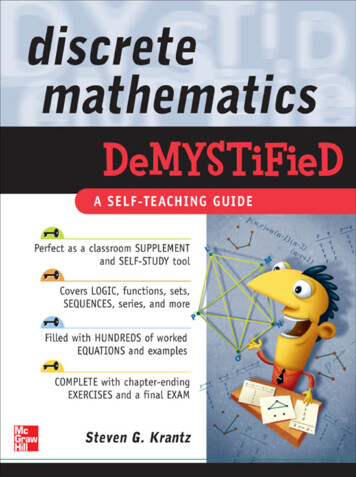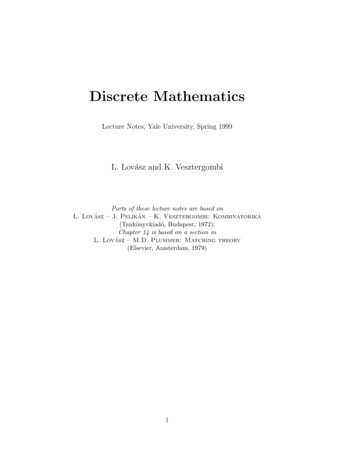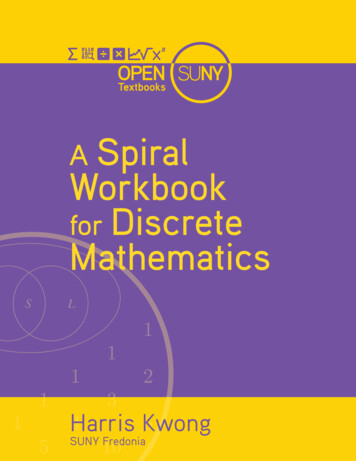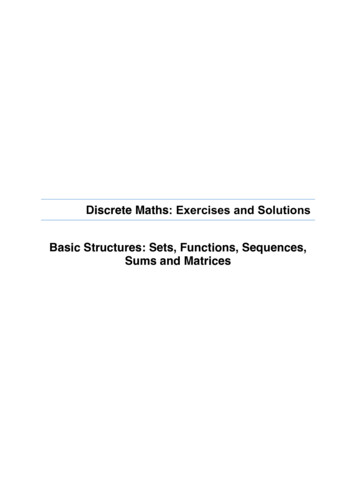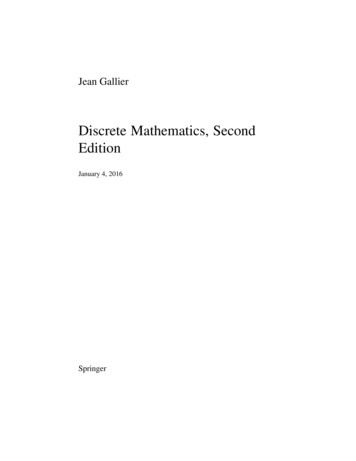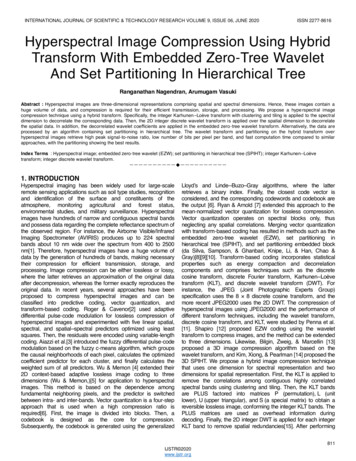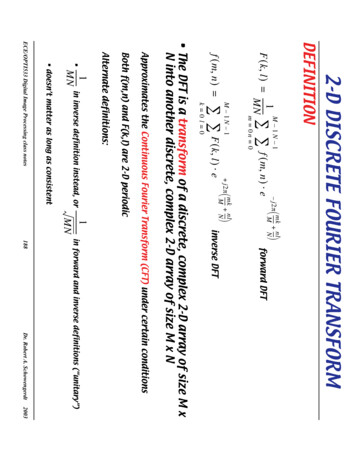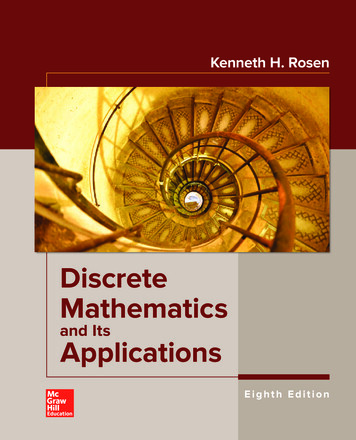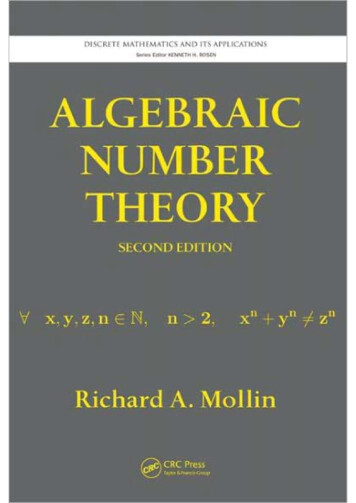
Transcription
DISCRETE MATHEMATICS AND ITS APPLICATIONSSeries Editor KENNETH H. ROSENALGEBRAICNUMBERTHEORYSECOND EDITIONRichard A. MollinUniversity of CalgaryAlberta, Canada
DISCRETEMATHEMATICSITS APPLICATIONSSeries EditorKenneth H. Rosen, Ph.D.R. B. J. T. Allenby and Alan Slomson, How to Count: An Introduction to Combinatorics,Third EditionDonald Bindner and Martin Erickson, A Student’s Guide to the Study, Practice, and Tools of ModernMathematicsJuergen Bierbrauer, Introduction to Coding TheoryFrancine Blanchet-Sadri, Algorithmic Combinatorics on Partial WordsRichard A. Brualdi and Dragos̆ Cvetković, A Combinatorial Approach to Matrix Theory and Its ApplicationsKun-Mao Chao and Bang Ye Wu, Spanning Trees and Optimization ProblemsCharalambos A. Charalambides, Enumerative CombinatoricsGary Chartrand and Ping Zhang, Chromatic Graph TheoryHenri Cohen, Gerhard Frey, et al., Handbook of Elliptic and Hyperelliptic Curve CryptographyCharles J. Colbourn and Jeffrey H. Dinitz, Handbook of Combinatorial Designs, Second EditionMartin Erickson, Pearls of Discrete MathematicsMartin Erickson and Anthony Vazzana, Introduction to Number TheorySteven Furino, Ying Miao, and Jianxing Yin, Frames and Resolvable Designs: Uses, Constructions,and ExistenceMark S. Gockenbach, Finite-Dimensional Linear AlgebraRandy Goldberg and Lance Riek, A Practical Handbook of Speech CodersJacob E. Goodman and Joseph O’Rourke, Handbook of Discrete and Computational Geometry,Second EditionJonathan L. Gross, Combinatorial Methods with Computer ApplicationsJonathan L. Gross and Jay Yellen, Graph Theory and Its Applications, Second EditionJonathan L. Gross and Jay Yellen, Handbook of Graph TheoryDavid S. Gunderson, Handbook of Mathematical Induction: Theory and ApplicationsDarrel R. Hankerson, Greg A. Harris, and Peter D. Johnson, Introduction to Information Theory andData Compression, Second EditionDarel W. Hardy, Fred Richman, and Carol L. Walker, Applied Algebra: Codes, Ciphers, andDiscrete Algorithms, Second Edition
Titles (continued)Daryl D. Harms, Miroslav Kraetzl, Charles J. Colbourn, and John S. Devitt, Network Reliability:Experiments with a Symbolic Algebra EnvironmentSilvia Heubach and Toufik Mansour, Combinatorics of Compositions and WordsLeslie Hogben, Handbook of Linear AlgebraDerek F. Holt with Bettina Eick and Eamonn A. O’Brien, Handbook of Computational Group TheoryDavid M. Jackson and Terry I. Visentin, An Atlas of Smaller Maps in Orientable and NonorientableSurfacesRichard E. Klima, Neil P. Sigmon, and Ernest L. Stitzinger, Applications of Abstract Algebrawith Maple and MATLAB , Second EditionPatrick Knupp and Kambiz Salari, Verification of Computer Codes in Computational Scienceand EngineeringWilliam Kocay and Donald L. Kreher, Graphs, Algorithms, and OptimizationDonald L. Kreher and Douglas R. Stinson, Combinatorial Algorithms: Generation Enumeration and SearchC. C. Lindner and C. A. Rodger, Design Theory, Second EditionHang T. Lau, A Java Library of Graph Algorithms and OptimizationElliott Mendelson, Introduction to Mathematical Logic, Fifth EditionAlfred J. Menezes, Paul C. van Oorschot, and Scott A. Vanstone, Handbook of Applied CryptographyRichard A. Mollin, Advanced Number Theory with ApplicationsRichard A. Mollin, Algebraic Number Theory, Second EditionRichard A. Mollin, Codes: The Guide to Secrecy from Ancient to Modern TimesRichard A. Mollin, Fundamental Number Theory with Applications, Second EditionRichard A. Mollin, An Introduction to Cryptography, Second EditionRichard A. Mollin, QuadraticsRichard A. Mollin, RSA and Public-Key CryptographyCarlos J. Moreno and Samuel S. Wagstaff, Jr., Sums of Squares of IntegersDingyi Pei, Authentication Codes and Combinatorial DesignsKenneth H. Rosen, Handbook of Discrete and Combinatorial MathematicsDouglas R. Shier and K.T. Wallenius, Applied Mathematical Modeling: A Multidisciplinary ApproachAlexander Stanoyevitch, Introduction to Cryptography with Mathematical Foundations andComputer ImplementationsJörn Steuding, Diophantine AnalysisDouglas R. Stinson, Cryptography: Theory and Practice, Third EditionRoberto Togneri and Christopher J. deSilva, Fundamentals of Information Theory and Coding DesignW. D. Wallis, Introduction to Combinatorial Designs, Second EditionW. D. Wallis and J. C. George, Introduction to CombinatoricsLawrence C. Washington, Elliptic Curves: Number Theory and Cryptography, Second Edition
Chapman & Hall/CRCTaylor & Francis Group6000 Broken Sound Parkway NW, Suite 300Boca Raton, FL 33487-2742 2011 by Taylor and Francis Group, LLCChapman & Hall/CRC is an imprint of Taylor & Francis Group, an Informa businessNo claim to original U.S. Government worksPrinted in the United States of America on acid-free paper10 9 8 7 6 5 4 3 2 1International Standard Book Number: 978-1-4398-4598-1 (Hardback)This book contains information obtained from authentic and highly regarded sources. Reasonable efforts have beenmade to publish reliable data and information, but the author and publisher cannot assume responsibility for the validity of all materials or the consequences of their use. The authors and publishers have attempted to trace the copyrightholders of all material reproduced in this publication and apologize to copyright holders if permission to publish in thisform has not been obtained. If any copyright material has not been acknowledged please write and let us know so we mayrectify in any future reprint.Except as permitted under U.S. Copyright Law, no part of this book may be reprinted, reproduced, transmitted, or utilized in any form by any electronic, mechanical, or other means, now known or hereafter invented, including photocopying, microfilming, and recording, or in any information storage or retrieval system, without written permission from thepublishers.For permission to photocopy or use material electronically from this work, please access www.copyright.com (http://www.copyright.com/) or contact the Copyright Clearance Center, Inc. (CCC), 222 Rosewood Drive, Danvers, MA 01923,978-750-8400. CCC is a not-for-profit organization that provides licenses and registration for a variety of users. Fororganizations that have been granted a photocopy license by the CCC, a separate system of payment has been arranged.Trademark Notice: Product or corporate names may be trademarks or registered trademarks, and are used only foridentification and explanation without intent to infringe.Visit the Taylor & Francis Web site athttp://www.taylorandfrancis.comand the CRC Press Web site athttp://www.crcpress.com
For Kate Mollin
ContentsPreface . . . . . . . . . . . . . . . . . . . . . . . . . . . . . . . . . . . . . . . . . . . . . . . . . . . . . . . . . . . . . . . .ixAbout the Author . . . . . . . . . . . . . . . . . . . . . . . . . . . . . . . . . . . . . . . . . . . . . . . . . . . . . xiiiSuggested Course Outlines . . . . . . . . . . . . . . . . . . . . . . . . . . . . . . . . . . . . . . . . . . . . . xv1 Integral Domains, Ideals, and Unique Factorization1.1 Integral Domains . . . . . . . . . . . . . . . . . . .1.2 Factorization Domains . . . . . . . . . . . . . . . .1.3 Ideals . . . . . . . . . . . . . . . . . . . . . . . . . . .1.4 Noetherian and Principal Ideal Domains . . . .1.5 Dedekind Domains . . . . . . . . . . . . . . . . . .1.6 Algebraic Numbers and Number Fields . . . . .1.7 Quadratic Fields . . . . . . . . . . . . . . . . . . . .11715202535442 Field Extensions2.1 Automorphisms, Fixed Points, and Galois Groups2.2 Norms and Traces . . . . . . . . . . . . . . . . . . . . .2.3 Integral Bases and Discriminants . . . . . . . . . . .2.4 Norms of Ideals . . . . . . . . . . . . . . . . . . . . . .55556570833 Class Groups3.1 Binary Quadratic Forms . . . .3.2 Forms and Ideals . . . . . . . . .3.3 Geometry of Numbers and the3.4 Units in Number Rings . . . .3.5 Dirichlet’s Unit Theorem . . . . . . . . . . . . . . . . . . . . . . . . . . .Ideal Class Group. . . . . . . . . . . . . . . . . . . . . . . . .8787961081221304 Applications: Equations and Sieves4.1 Prime Power Representation .4.2 Bachet’s Equation . . . . . . . .4.3 The Fermat Equation . . . . . .4.4 Factoring . . . . . . . . . . . . . .4.5 The Number Field Sieve . . . .139139145149165174Ideals. . . . . . . . . . . . .181181196213221.5 Ideal Decomposition in Number Fields5.1 Inertia, Ramification, and Splitting5.2 The Different and Discriminant . .5.3 Ramification . . . . . . . . . . . . . .5.4 Galois Theory and Decomposition .vii.of Prime. . . . . . . . . . . . . . . .
viii5.55.65.7Kummer Extensions and Class-Field Theory . . . . . . . . . . . . . .The Kronecker-Weber Theorem . . . . . . . . . . . . . . . . . . . . . .An Application—Primality Testing . . . . . . . . . . . . . . . . . . . .6 Reciprocity Laws6.1 Cubic Reciprocity . . . . . . . . . .6.2 The Biquadratic Reciprocity Law6.3 The Stickelberger Relation . . . .6.4 The Eisenstein Reciprocity Law .233244255261261278294311Appendix A: Abstract Algebra . . . . . . . . . . . . . . . . . . . . . . . . . . . . . . . . . . . . . . . . 319Appendix B: Sequences and Series . . . . . . . . . . . . . . . . . . . . . . . . . . . . . . . . . . . . . 345Appendix C: The Greek Alphabet . . . . . . . . . . . . . . . . . . . . . . . . . . . . . . . . . . . . . 355Appendix D: Latin Phrases . . . . . . . . . . . . . . . . . . . . . . . . . . . . . . . . . . . . . . . . . . . . 357Bibliography . . . . . . . . . . . . . . . . . . . . . . . . . . . . . . . . . . . . . . . . . . . . . . . . . . . . . . . . . . . 359Solutions to Odd-Numbered Exercises . . . . . . . . . . . . . . . . . . . . . . . . . . . . . . . . . 365
PrefaceThis is the second edition of a text that is intended for a one-semester course in algebraicnumber theory for senior undergraduate and beginning graduate students. The Table ofContents on pages vii–viii is essentially self-descriptive of each chapter’s contents, requiring no need for repetition here. What differs from the first edition deserves elucidation.Comments from numerous instructors and students over more than a decade since the firstedition appeared have given way to a new style, methodology, and presentation.The focus has changed from the first edition approach of introducing algebraic numbersand number fields in the first two chapters and leaving ideals until Chapter 3, to the secondedition strategy of looking at integral domains, ideals and unique factorization in Chapter1 and field extensions including Galois theory in Chapter 2. This changes the first editionmethod of having the entirety of Galois theory relegated to an appendix and bringing it,in this edition, to the main text in a more complete, comprehensive, and involved fashion.Chapter 3 in this edition is devoted to the study of class groups, and as a new feature, nottouched in the first edition, we include the study of binary quadratic forms and comparisonof the ideal and form class groups, which leads into the general ideal class group discussionand paves the way for the geometry of numbers and Dirichlet’s Unit Theorem. In the firstedition, this was done in Chapter 2 along with applications to the number field sieve. In thisedition, the applications are put into a separate Chapter 4 including the number field sieve in§4.5, introduced via §4.4 on factoring, including Pollard’s cubic factoring algorithm, which ismore comprehensive than that of the first edition. In turn, §4.1–§4.3 are applications leadingto the latter that involve solutions of Diophantine equations including Bachet, Fermat, andprime power representation. This includes Kummer’s proof of Fermat’s Last Theorem (FLT)for regular primes, Case I, which was put into Chapter 3 in the first edition. This editionmaintains the inclusion of Bernoulli numbers, the Riemann zeta function, and connectionsvia von Staudt–Clausen to the infinitude of irregular primes. Applications also appear atthe end of Chapter 5 with an overview of primality testing and, as an application of theKronecker–Weber Theorem, Lenstra’s primality test employing the Artin symbol. A specialcase of this test is presented as the Lucas–Lehmer test for Mersenne primes.Chapter 5 replaces Chapter 4 of the first edition in its discussion of ideal decomposition innumber fields but spreads out the number of sections to more evenly present the material.One feature of the second edition that distinguishes it from the first is that there is muchless emphasis on using exercises with the framework of proofs in the main text. Exercisesare referenced in the proofs only when they represent material that is routine and moreappropriate for a student to do. Throughout the text, this is one of the major changes. Inparticular, in the proof of the Kronecker–Weber Theorem, as well as in the proofs of thereciprocity laws in Chapter 6, what were exercises in the first edition are now explained infull in the main text. Moreover, exercises in this edition are designed to test and challengethe reader, as well as illustrate concepts both within the main text as well as extend thoseideas. For instance, in the exercises for §2.1, Galois theory is expanded from the numberfield case to finite fields and general fields of characteristic zero which is then invoked in§5.4 to discuss residue class fields and connections with the Frobenius automorphism. Thus,the reader is led at a measured pace through the material to a clear understanding of thepinnacles of algebraic number theory. What is not included from the first edition is anyseparate discussion of elliptic curves. This is done to make the text more self-containedas a one-semester course for which the addition of the latter is better placed in a relatedcourse such as given in [54]. Also, the numbering system has changed from the first editionconsecutive numbering of all objects to the standard method in this edition.ix
xAlgebraic Number Theory Features of This Text The book is ideal for the student since it is exercise-rich with over 310 problems. Themore challenging exercises are marked with the symbol . Also, complete and detailedsolutions to all of the odd-numbered exercises are given in the back of the text. Throughoutthe text, the reader is encouraged to solve exercises related to the topics at hand. Completeand detailed solutions of the even-numbered exercises are included in a Solutions Manual,which is available from the publisher for the qualified instructor. The text is accessible to anyone, from the senior undergraduate to the research scientist.The main prerequisites are the basics of a first course in abstract algebra, the fundamentalsof an introductory course in elementary number theory, and some knowledge of basic matrixtheory. In any case, the appendices, as described below, contain a review of all of therequisite background material. Essentially, the mature student, with a knowledge of algebra,can work through the book without any serious impediment or need to consult another text. There are more than forty mini-biographies of those who helped develop algebraic numbertheory from its inception. These are given, unlike the footnote approach of the first edition,in boxed highlighted text throughout, to give a human face to the mathematics beingpresented, and set so they do not interfere with the flow of the discourse. Thus, the readerhas immediate information at will, or may treat them as digressions, and access them laterwithout significantly interfering with the main mathematical text at hand. Our appreciationof mathematics is deepened by a knowledge of the lives of these individuals. I have avoidedthe current convention of gathering notes at the end of each chapter, since the immediacyof information is more important. There are applications via factoring, primality testing, and solving Diophantine equationsas described above. In §4.5, we also discuss the applications to cryptography. The appendices are given, for the convenience of the reader, to make the text selfcontained. Appendix A is a meant as a convenient fingertip reference for abstract algebrawith an overview of all the concepts used in the main text. Appendix B is an overviewof sequences and series, including all that is required to develop the concepts. AppendixC consists of the Greek alphabet with English transliteration. Students and research mathematicians alike have need of the latter in symbolic presentations of mathematical ideas.Thus, it is valuable to have a table of the symbols, and their English equivalents readilyat hand. Appendix D has a table of numerous Latin phrases and their English equivalents,again important since many Latin phrases are used in mathematics, and historically muchmathematics was written in Latin such as Bachet’s Latin translation of Diophantus’ Greekbook Arithmetica. The list of symbols is designed so that the reader may determine, at a glance, on whichpage the first defining occurrence of a desired notation exists. The index has over two thousand entries, and has been devised in such a way to ensurethat there is maximum ease in getting information from the text. There is maximum crossreferencing to ensure that the reader will find ease-of-use in extracting information to beparamount. The bibliography has over seventy entries for the reader to explore concepts not covered inthe text or to expand knowledge of those covered. This includes a page reference for eachand every citing of a given item, so that no guesswork is involved as to where the referenceis used. The Web page cited in the penultimate line will contain a file for comments, and anytypos/errors that are found. Furthermore, comments via the e-mail address on the bottomline are also welcome.
Prefacexi Acknowledgments The author is grateful for the proofreading done by the followingpeople: John Burke (U.S.A.), Bart Goddard (U.S.A.), Sebastian Linder, and Matt Tesarski(Canada—both students of mine in 2010), Keith Matthews (Australia), Anitha Srinivasan(India), Gopala Srinivasan (India), and Thomas Zapplachinski (Canada—former student,now cryptographer in the field).Richard Mollin, Calgary, Canadawebsite: http://www.math.ucalgary.ca/ ramollin/email: ramollin@math.ucalgary.ca
xiiiAbout the AuthorRichard Anthony Mollin is a professor in the mathematics department at the University ofCalgary. Over the past quarter century, he has been awarded six Killam Resident Fellowships. He has written over 200 publications including 12 books in algebra, number theory,and computational mathematics. He is a past member of the Canadian and AmericanMathematical Societies, the Mathematical Association of America and is a member of various editorial boards. He has been invited to lecture at numerous universities, conferencesand scientific society meetings and has held several research grants from universities andgovernmental agencies. He is the founder of the Canadian Number Theory Association andhosted its first conference and a NATO Advanced Study Institute in Banff in 1988—see[47]–[48].On a personal note—in the 1970s he owned a professional photography business, Touch Mewith Your Eyes, and photographed many stars such as Paul Anka, David Bowie, Cher, BobDylan, Peter O’Toole, the Rolling Stones, and Donald Sutherland. His photographs werepublished in The Toronto Globe and Mail newspapers as well as New Music Magazine andelsewhere. Samples of his work can be viewed online athttp://math.ucalgary.ca/ ramollin/pixstars.html.His passion for mathematics is portrayed in his writings—enjoyed by mathematicians andthe general public. He has interests in the arts, classical literature, computers, movies, andpolitics. He is a patron and a benefactor of the Alberta Ballet Company, Alberta TheatreProjects, the Calgary Opera, the Calgary Philharmonic Orchestra, and Decidedly JazzDanceworks. His love for life comprises cooking, entertaining, fitness, health, photography,and travel, with no plans to slow down or retire in the foreseeable future.
Suggested Course OutlinesA glance at the Table of Contents will reveal that there is a wealth of material beyonda basic course in algebraic number theory. This section is intended for the instructor, bygiving several routes from a course in the basics of algebraic number theory to a moreadvanced course with numerous applications, as well as other aspects such as Kummer’sproof of FLT for regular primes, and advanced reciprocity laws.Chapters 1 through 3 are essential as a foundation, whereas Chapter 4 is optional, and theinstructor may skip it or add any section as an application of the material in the previouschapters. §4.4–§4.5 go together as advanced material on factoring, with §4.4 preparatorymaterial using Pollard’s algorithm to set the stage for the description of the number fieldsieve in §4.5.In §5.1–§5.4, the groundwork is laid for ramification theory. However, in §5.5, the theory ofKummer extensions and applications to Kummer’s proof of FLT for regular primes in thesecond case may be eliminated from a basic course in algebraic number theory. §5.6 on theproof of the Kronecker–Weber theorem, is a significant application of what has gone before,but is again not necessary for a basic course. §5.7 is an applications section on primalitytesting.In a bare-bones course, one does not need to proceed into Chapter 6. However, the chapter illustrates some of the pinnacles of algebraic number theory with proofs of the cubic,biquadratic, and Eisenstein reciprocity laws, as well as development of the Stickelberger relation. In a more advanced course, these topics should be included. The following diagramis a schematic flow-chart to illustrate the possible routes for the course, from the most basiccourse to one filled with applications.xv
xviAlgebraic Number TheoryCourse OutlinesBackgroundCoreOptionalAdvanced Sec. 1.1–1.7Appendix A Sec. 2.1–2.4 Sec. 3.1–3.5 Appendix B Sec. 4.1–4.3 Sec. 5.1–5.4 Sec. 4.4–4.5 Sec. 5.5–5.6 Sec. 6.1–6.4 Sec. 5.7
Chapter 1Integral Domains, Ideals, andUnique FactorizationTake care of your body with steadfast fidelity. The soul must see through these eyesalone, and if they are dim, the whole world is clouded.Johann Wolfgang von Goethe (1749–1832), German poet, novelist, anddramatistIn this chapter, we introduce integral domains, and develop the concepts of divisibility,irreducibility, and primes which we apply to Dedekind domains. This preamble allows us todevelop Noetherian, principal ideal, and unique factorization domains later in the chapterthereby setting the foundation for the introduction of algebraic number rings and numberfields. The reader should be familiar with some basic abstract algebra, such as groups, rings,and fields and their properties, which are reviewed in Appendix A, starting on page 319,for convenience and finger-tip reference.1.1Integral DomainsIn order to define concepts in the sequel, we will need the following.Definition 1.1 — UnitsAn element α in a commutative ring R with identity 1R is called a unit in R when there isa β R such that αβ 1R . The multiplicative group of units in R is denoted by UR —seeExercise 1.7 on page 6.Example 1.1 In Z[ 2] R, 1 2 is a unit, since (1 2)( 1 2) 1R 1.For the following, recall that a zero divisor in a commutative ring R is a nonzero elementα R such that αβ 0 where β 0.Definition 1.2 — Integral DomainsAn integral domain is a commutative ring D with identity 1D , having no zero divisors. Inparticular, if every nonzero element is a unit, then D is a field.1
21. Integral Domains, Ideals, and Unique FactorizationApplication 1.1 — The Cancellation LawOne of the most important properties of an integral domain D is that the cancellation lawholds, namely if α,β D with α nonzero and αβ αγ, then β γ.Example 1.2 The ordinary or rational integersZ {. . . , 2, 1, 0, 1, 2, . . .}provide us with our first example of an integral domain.Example 1.3 For any nonsquare integer n, Z[ n] {a b D : a, b Z}is an example of an integral domain.For example, if n 1, we have the Gaussian integers. Indeed, n 1 yields 1 i which is an example of a special kind of unit, thegeneralization of which we now define.Definition 1.3 — Primitive Roots of UnityFor m N {1, 2, 3, . . .} the natural numbers ζm denotes a primitive m th root of unity,which is a root of xm 1, but not a root of xd 1 for any natural number d m. Example 1.4 With reference to Example 1.3, where n 1, 1 i ζ4 is a primitivefourth root of unity, since it is a root of x4 1, but not root of xj 1 for j 1, 2, 3. Also, ζ3 ( 1 3)/2is a primitive cube root of unity, since it is a root of x3 1, but clearly not a root of x2 1or x 1.Example 1.5 Suppose that p is a prime and ζp is a primitive p-th root of unity. If we setx p 1 ζpjj 0thenxζp p 1 j 0ζpj 1 p 1 ζpj x.(1.1)j 0Thus, if x 0, dividing through (1.1) by x gives ζp 1, a contradiction. Thus,1 ζp ζp2 · · · ζpp 1 0.This fact will prove useful when discussing notions surrounding roots of unity later inthe text—see Exercise 2.25 on page 69, for instance. Also, we generalize this example inExercise 6.28 on page 310.
1.1. Integral Domains3Example 1.3 is a motivator for the more general concept, which later turns out to be theso-called “ring of integers of a quadratic field”—see Theorem 1.28 on page 45.Application 1.2 — Quadratic Domains and Norms If n is a nonsquare domain as given in Example 1.3, where integer, then Z[ n] is an integraln). We call domains in Q( n) quadraticwe note that Z[ n] is a subset of the field Q( domains. There is a slightly larger subset of Q( n) that is also an integral domain whenn 1 (mod 4)—see Exercise 1.1 on page 6 1 n Q( n).Z2Now we may combine Example 1.3 with this application to describe some special quadraticdomains as follows. DefineZ[ωn ] {a bωn : a, b Z},whereωn (1 n n)/2if n 1 (mod 4),if n 1 (mod 4).Then Z[ωn ] is a quadratic domain.Another concept we will see in greater generality later, but applied here to quadratic domains, is the quadratic norm N : Q( n) Q via N (a b n) (a b n)(a b n) a2 nb2 Q.In particular, by Exercise 1.3α UZ[ωn ] if and only if N (α) 1.We will be using the concept of a norm throughout our discussion to establish propertiesof, in this case, quadratic domains, or in general, rings of integers, that we have yet todefine—see Definition 1.30 on page 36.The notion of divisibility of elements in an integral domain is a fundamental starting pointfor understanding how algebraic number theory generalizes the notions of “divisibility,”“primality,” and related concepts from the integers Z to other integral domains such asZ[ωn ].Definition 1.4 — Divisors and Trivial FactorizationsIf α,β D an integral domain, then α is said to be a divisor of β, if there exists an elementγ D such that β αγ, denoted by α β. If α does not divide β, then we denote this byα β. If β αγ, where either α UD or γ UD , then this is called a trivial factorizationof β.Example 1.6 Consider the notion of units given in Definition on page 1 and the 1.1illustration given in Example 1.1. Then we have that both (1 2) 1 and ( 1 2) 1.Indeed, this may be said to characterize units in D, namely α is a unit in an integral domain D if and only if α 1.This may be used as an alternative to that of Definition 1.1. The following notion allowsfor the introduction of a different approach.
41. Integral Domains, Ideals, and Unique FactorizationDefinition 1.5 — Associates If D is an integral domain and α,β D with α β and β α, then α and β are said to beassociates, and we denote this by α β. If α and β are not associates, we denote this byα β.Example 1.7 From Definition 1.5 and Example 1.6, we see that α is a unit in an integraldomain D if and only if α 1. Furthermore, if α β for any α,β D, then there is a unit u D such that α uβ. To see this, since α β, then there is a γ D such that β γα. Conversely since β α, there is a δ D such that α δβ. Hence, α δβ δγα, so by thecancellation law exhibited in Application 1.1 on page 2, 1 δγ, so δ γ 1 u is a unitand α uβ. Example 1.8 In Z[ 10], 2 10 16 5 10 since 16 5 10 (2 10)(3 10), so (2 10) (16 5 10), and 2 10 (16 5 10)( 3 10) so (16 5 10) (2 10).Example 1.9 Since 6 (4 10)(4 10), then (4 10) 6 in Z[ 10].Notice that 6 2 · 3 so it appears that 6 does not have a “uniqueness of factorization”in Z[ 10] in some sense that we now must make clear and rigorous. Now we develop thenotions to describe this phenomenon which is distinct from Z where 6 does have uniquefactorization via the Fundamental Theorem of Arithmetic. In fact, in Z, a prime, is definedto be an integer p such that the only divisors are 1 and p. Thus, primes satisfy that if p ab, then either p a or p b(1.2)—see [53, Lemma 1.2, p. 32]. Also, primes in Z satisfy thatif p ab, then a 1 or b 1.(1.3)The following generalizes property (1.3) to arbitrary integral domains. Then we will discussproperty (1.2) and show how (1.2)–(1.3) generalize to similar notions in general integraldomains.Definition 1.6 — IrreduciblesIf D is an integral domain and a nonzero, nonunit element β D satisfies the property thatwhenever β αγ, then either α UD or γ UD , then β is said to be irreducible. In otherwords, the irreducible elements of D are the nonzero, nonunit elements having only trivialfactoriza
Kenneth H. Rosen, Handbook of Discrete and Combinatorial Mathematics Douglas R. Shier and K.T. Wallenius, Applied Mathematical Modeling: A Multidisciplinary Approach Alexander Stanoyevitch, Introduction to Cryptography with Mathematical Foundations and Computer Implementations Jörn Steuding, Diophantine Analysis


